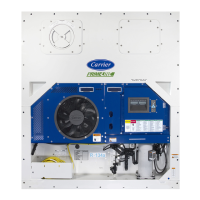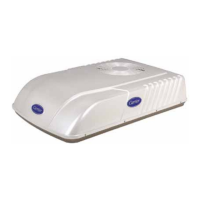6−2T-364
6.3 SERVICE CONNECTIONS
The compressor suction, compressor discharge, and
the liquid line service valves (see Figure 6−3) are pro-
vided with a double seat and an access valve which en-
ables servicing of the compressor and refrigerant lines.
Turning the valve stem clockwise (all the way forward)
will frontseat the valve to close off the line connection
and open a path to the access valve. Turning the stem
counterclockwise (all the way out) will backseat the
valve to open the line connection and close off the path
to the access valve.
With the valve stem midway between frontseat and
backseat, both of the service valve connections are
open to the access valve path.
For example, the valve stem is first fully backseated
when connecting a manifold gauge to measure
pressure. Then, the valve is opened 1/4 to 1/2 turn to
measure the pressure.
1
2
3
4
5
6
7
1. Line Connection
2. Access Valve
3. Stem Cap
4. Valve stem
5. Compressor Or Filter
Drier Inlet Connection
6. Valve (Frontseated)
7. Valve (Backseated)
Figure 6−3 Service Valve
Connection of the manifold gauge/hose set (see
Figure 6−4) is dependent on the component being
serviced. If only the compressor is being serviced, the
high side coupling is connected to the discharge service
valve.
For service of the low side (after pump down), the high
side coupling is connected to the liquid line service
valve. The center hose connection is brought to the tool
being used (vacuum, tank, etc.).
Connecting the manifold gauge set:
a. Remove service valve stem cap and to make sure the
valve is backseated.
b. Remove access valve cap (See Figure 6−3).
c. Connect the field service coupling (see Figure 6−2) to
the access valve.
d. Turn the field service coupling knob clockwise, which
will open the system to the gauge set.
e. To read system pressures, slightly midseat the ser-
vice valve.
f. Repeat the procedure to connect the other side of the
gauge set.
CAUTION
To prevent trapping liquid refrigerant in the
manifold gauge set be sure set is brought to
suction pressure before disconnecting.
Removing the Manifold Gauge Set:
a. While the compressor is still ON, backseat the high
side service valve.
b. Midseat both hand valves on the manifold gauge set
and allow the pressure in the manifold gauge set to be
drawn down to low side pressure. This returns any liq-
uid that may be in the high side hose to the system.
c. Backseat the low side service valve. Backseat both
field service couplings and frontseat both manifold
hand valves. Remove couplings from access valves.
d. Install both service valve stem caps and service port
caps (finger-tight only).
6.4 PUMP DOWN THE UNIT
To service the filter drier, economizer, expansion valves,
economizer solenoid valve, digital unloader valve or
evaporator coil, pump the refrigerant into the high side
as follows:
CAUTION
The scroll compressor achieves low suc-
tion pressure very quickly. Do not use the
compressor to evacuate the system below
0 psig. Never operate the compressor with
the suction or discharge service valves
closed (frontseated). Internal damage will
result from operating the compressor in a
deep vacuum.
a. Attach manifold gauge set to the compressor suction
and discharge service valves. Refer to paragraph 6.2.
b. Start the unit and run in the frozen mode (controller
set below -10C (14F) for 10 to 15 minutes.
c. Check function code Cd21 (refer to paragraph 3.2.2).
The economizer solenoid valve should be open. If
not, continue to run until the valve opens.
d. Frontseat the liquid line service valve. Place Start-
Stop switch in the OFF position when the suction
reaches a positive pressure of 0.1 bar (1.4 psig).
e. Frontseat the suction and discharge service valves.
The refrigerant will be trapped between the compres-
sor discharge service valves and the liquid line valve.
f. Before opening up any part of the system, a slight
positive pressure should be indicated on the pressure
gauge. Remove power from the unit before opening
any part of the system. If a vacuum is indicated, emit
refrigerant by cracking the liquid line valve momen-
tarily to build up a slight positive pressure.
g. When opening up the refrigerant system, certain
parts may frost. Allow the part to warm to ambient
temperature before dismantling. This avoids internal
condensation which puts moisture in the system.

